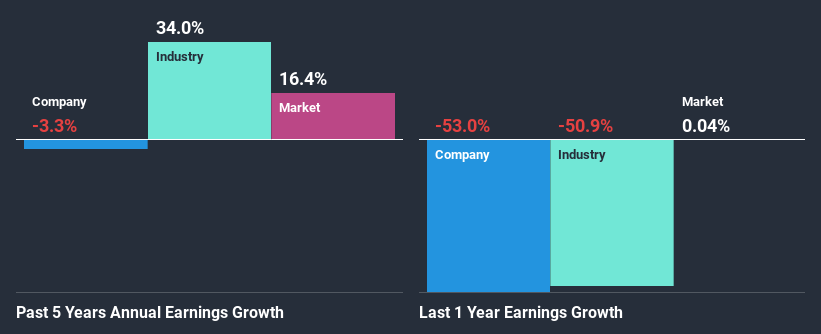Are Poor Financial Prospects Dragging Down PrairieSky Royalty Ltd. (TSE:PSK Stock?

With its stock down 7.3% over the past three months, it is easy to disregard PrairieSky Royalty (TSE:PSK). Given that stock prices are usually driven by a company’s fundamentals over the long term, which in this case look pretty weak, we decided to study the company's key financial indicators. Specifically, we decided to study PrairieSky Royalty's ROE in this article.
Return on equity or ROE is a key measure used to assess how efficiently a company's management is utilizing the company's capital. Simply put, it is used to assess the profitability of a company in relation to its equity capital.
See our latest analysis for PrairieSky Royalty
How Do You Calculate Return On Equity?
The formula for return on equity is:
Return on Equity = Net Profit (from continuing operations) ÷ Shareholders' Equity
So, based on the above formula, the ROE for PrairieSky Royalty is:
2.0% = CA$49m ÷ CA$2.4b (Based on the trailing twelve months to June 2020).
The 'return' is the profit over the last twelve months. One way to conceptualize this is that for each CA$1 of shareholders' capital it has, the company made CA$0.02 in profit.
What Has ROE Got To Do With Earnings Growth?
We have already established that ROE serves as an efficient profit-generating gauge for a company's future earnings. Based on how much of its profits the company chooses to reinvest or "retain", we are then able to evaluate a company's future ability to generate profits. Assuming everything else remains unchanged, the higher the ROE and profit retention, the higher the growth rate of a company compared to companies that don't necessarily bear these characteristics.
A Side By Side comparison of PrairieSky Royalty's Earnings Growth And 2.0% ROE
It is hard to argue that PrairieSky Royalty's ROE is much good in and of itself. Even compared to the average industry ROE of 8.0%, the company's ROE is quite dismal. Therefore, it might not be wrong to say that the five year net income decline of 3.3% seen by PrairieSky Royalty was possibly a result of it having a lower ROE. We believe that there also might be other aspects that are negatively influencing the company's earnings prospects. Such as - low earnings retention or poor allocation of capital.
So, as a next step, we compared PrairieSky Royalty's performance against the industry and were disappointed to discover that while the company has been shrinking its earnings, the industry has been growing its earnings at a rate of 34% in the same period.
Earnings growth is a huge factor in stock valuation. It’s important for an investor to know whether the market has priced in the company's expected earnings growth (or decline). By doing so, they will have an idea if the stock is headed into clear blue waters or if swampy waters await. What is PSK worth today? The intrinsic value infographic in our free research report helps visualize whether PSK is currently mispriced by the market.
Is PrairieSky Royalty Using Its Retained Earnings Effectively?
PrairieSky Royalty's very high three-year median payout ratio of 179% over the last three years suggests that the company is paying its shareholders more than what it is earning and this explains the company's shrinking earnings. Paying a dividend beyond their means is usually not viable over the long term. Our risks dashboard should have the 3 risks we have identified for PrairieSky Royalty.
In addition, PrairieSky Royalty has been paying dividends over a period of six years suggesting that keeping up dividend payments is preferred by the management even though earnings have been in decline. Our latest analyst data shows that the future payout ratio of the company is expected to drop to 102% over the next three years. However, the company's ROE is not expected to change by much despite the lower expected payout ratio.
Summary
In total, we would have a hard think before deciding on any investment action concerning PrairieSky Royalty. Specifically, it has shown quite an unsatisfactory performance as far as earnings growth is concerned, and a poor ROE and an equally poor rate of reinvestment seem to be the reason behind this inadequate performance. In addition, on studying the latest analyst forecasts, we found that the company's earnings are expected to continue to shrink. Are these analysts expectations based on the broad expectations for the industry, or on the company's fundamentals? Click here to be taken to our analyst's forecasts page for the company.
This article by Simply Wall St is general in nature. It does not constitute a recommendation to buy or sell any stock, and does not take account of your objectives, or your financial situation. We aim to bring you long-term focused analysis driven by fundamental data. Note that our analysis may not factor in the latest price-sensitive company announcements or qualitative material. Simply Wall St has no position in any stocks mentioned.
Have feedback on this article? Concerned about the content? Get in touch with us directly. Alternatively, email editorial-team@simplywallst.com.

 Yahoo Finance
Yahoo Finance 
